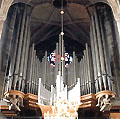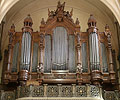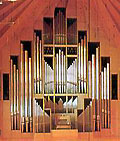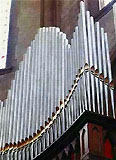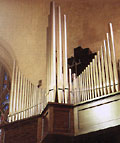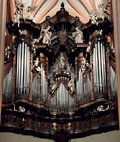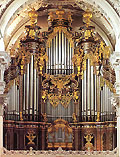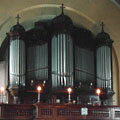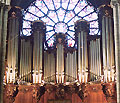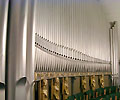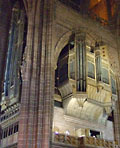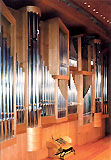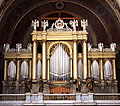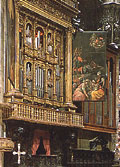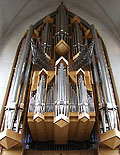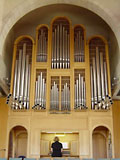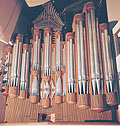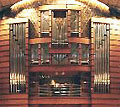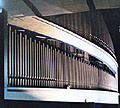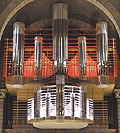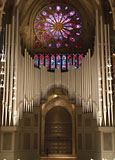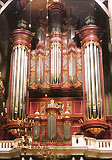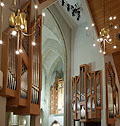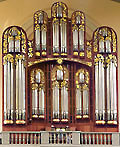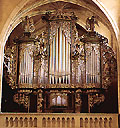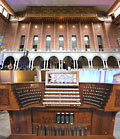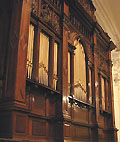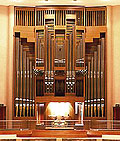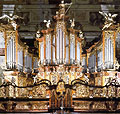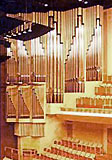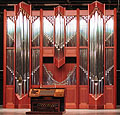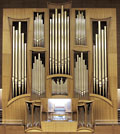
| In this section we are no longer concerned with the largest organs but with other highlights and oddities in the
world of organbuilding, like air cushion and reversible organs, open air organs, queer case constructions, the largest and longest organ stops et cetera – enjoy yourselves! I collected this information to show the diversity in organbuilding including some of the more bizarre specimens but also to deal with some FAQs and rumors about organs (like which one is the largest / largest still playable organ, the largest church organ / cathedral organ, mechanic organ, the largest organ built at one time, etc.) f course it has to be said that the mere size or any other superlative in an organ does not say a word about its quality (some people in different Internet forums seem to have thought so – I included some remarks in my annotations on this :-) |
By clicking on one of these buttons you can pass on directly to the section of the site that interests you most:
| The Oldest Organs in the World
Just like in determining the size of an organ here too we have a constant debate going on because not always organs can be safely dated back to their original year of construction – apart from the fact that they are frequently remodeled, enlarged and whatever – and then you can't always tell how much of the organ substance has really been there from the beginning because not all changes are well documented. |
||||
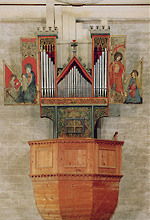 |
It is generally agreed upon that the organ in the
church of Notre-Dame-de-Valère at Sion (Switzerland) is the oldest playable organ in the world. Its oldest parts date as far back as 1435 (+/- 1 year), but they only include most of the case and 180 original pipes from the Gothic period. The light beige Subbass 16' pipes that you can see behind the facade as well as the pedal connected with them are later additions. |
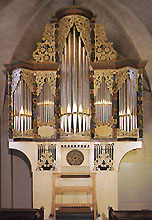 |
Some years ago another maybe even older organ has turned up, the organ of
St. Andreas at Soest-Ostönnen (Westfalia, Germany). Its basic substance, wind chest and divisions, is considered to date back to 1425-1430 and even half of the pipes are original. On the other hand case and key action only date back to a reconstruction in the Baroque period. Thus the Ostönnen organ is older in terms of acoustics but the Sion one in its optical appearance. |
|
| The next oldest organ from the Gothic period that is still almost completely preserved is in the
Krummhörn-Rysum (Germany) church and dates back to 1442. Especially in the Dutch-German area (Brabant) but also in France and on the
Mediterranean there do exist instruments containing 16th century or even older ranks and have survived the reconstruction craze of the following centuries fairly undamaged and have been
restored authentically. Have a look at the following examples: |
||||
|
• D, Lübeck, St. Jakobi, choir organ (1467) • NL, Groningen, Martinikerk (1482) • D, Kiedrich, St. Valentin and Dionysius (1500) • F, Lorris-en-Gâtinais, Eglise du Gros Bourg (1501) |
• NL, Alkmaar, Sint Laurenskerk, choir organ (1511) • NL, Breda, Grote Kerk (1534) • D, Lüneburg, St. Johannis (1553) • DK, Roskilde, Dom (1554) |
• A, Innsbruck, Hofkirche (1558) • P, Evora, Catedral (1562) • NL, Leiden, Hooglandse Kerk (1565) • D, Norden, St. Ludgeri (1567) |
||
Archaeologists have discovered parts of an organ in the basilica above the traditional birthplace of Christ in Bethlehem, Palestine, built in about the 11th or 12th century. It was used in the Church of the Nativity for nearly a century, until it was removed and hidden during a Muslim invasion at the end of the 12th century. It was apparently buried in wooden boxes. The organ pipes are in excellent condition. It is planned to reconstruct the complete organ true to the original. |
||||
| The Ultimate in Open Air: Open Air Organs I'm not kidding - there really are pipe organs that are installed outside (of course they sit under some kind of a roof) where they have to withstand wind and weather. You can well imagine that building such an organ is a special challenge to an organbuilder. The two largest of the kind are: |
||
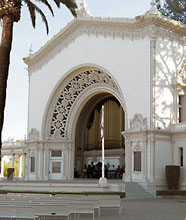 |
The organ in Spreckels
Pavillion, Balboa Park, San Diego (USA) was built in 1915 by Austin Organs Inc. (Hartford, USA) and has been enlarged several times (last in 2003) to now 73 ranks / 57 voices on four
manuals that command a total of 4,518 pipes - you may safely leave your hearing aids at home. This instrument didn't only fascinate thousands of people in its early years, even today San Diego open air organ concerts attract huge audiences. Also many school classes like to visit it and have their ears blasted off by its sheer volume. As a side effect they get an insight into the world of organs. Especially impressing is the Contra Bombarde 32' in the pedal that is standing on extremely high wind pressure and thus acoustically gives this monumental instrument its due foundation. |
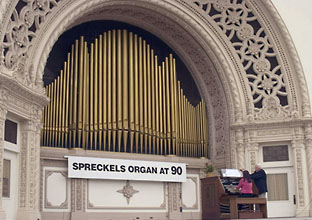 |
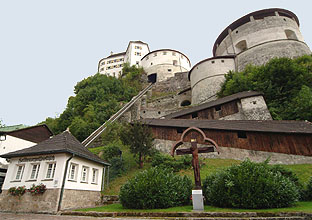 |
Several years later, in 1931, Oscar Walcker from Ludwigsburg, Germany built the so-called
"hero organ" in the fortress of Geroldseck in Kufstein, Austria. The somewhat strange name indicates that it was built in
remembrance of the soldiers killed in action during WW I. Today it is interpreted to be a "peace memorial" and playing the organ should serve as a memorial to all people killed in connection
with the two World Wars. In 1971-1986 the organ was renovated and enlarged to its present size of 82 ranks / 45 voices on four manuals. In ranks it is now larger than the San Diego organ but on the other hand it "only" has 4,307 pipes which is slightly less than in San Diego. The "hero organ" has a special 32' Bombarde in its pedal, too, as well as high-pressure stops galore so that it can make itself heard to a distance of 13 kilometers (7½ miles). |
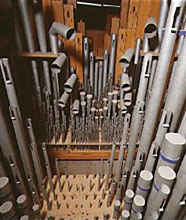 |
| The console has been placed about 100 meters (200 yards) away in a separate cabin (on the bottom left on the picture). The organist can check his play via loudspeaker or headphone without any time delay. | ||
| The Open Air Organ on the Truck |
|
| "If you can't get the people to the organ get the organ to the people." It must have been
something in the way that the Ostheim (Rhön, Germany) organbuilding company Hoffmann thought when in 1998 it built a sizeable organ (38 ranks / 29 voices / 2 manuals) into a truck. In order for the organ to survive its life on the move it has a special air suspension and automatic level control system. In addition it had to be shielded against insects (could it be that dead insects in the pipes do not exactly provide the perfect sound you were wishing for ? ;-) The organ has electric action so that the console is connected with the organ via a special cable and can be placed anywhere. |
 |
The "Wanderer" Organ with 12 transportable modules Between 2019 and 2020, Paolo Oreni had a transportable organ with 14 ranks built, These are distributed over 12 mobile modules with a total weight of 1.8 tons, from which 43 stops are extracted by single tone windchests, extensions and transmissions. Together with the free-standing console, this organ can be brought into any hall or church and set up ready for a concert in just a few hours. Here's the link to Paolo Oreni's website. |
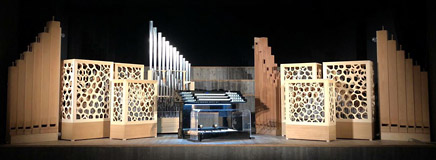 |
| The Only Reversible Organ in the World The job description for building the organ for the Metropolitan Art Space Concert Hall in Tokyo, Japan was to build an organ on which organ music could be played authentically no matter which period it came from. As this is simply impossible in one single organ, just think of the different ways of tuning, Marc Garnier from France in 1987-1991 built three organs in one with |
||
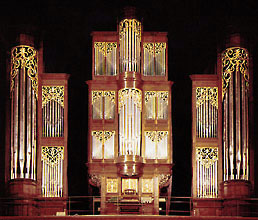 |
a total of 184 ranks / 123 voices (+ 2 ext. + 1 transm.) and more than 9,000 pipes with a
three-part case. Now, depending on which organ you need you can turn the right one to the front. Of course you need to disconnect and reconnect all pipes, the air system and the action,
a job that obviously is extremely complicated. Maybe that is the reason why this technical masterpiece is still singular in the whole World. To the left you can see the Classical facade of the organ that combines the Renaissance and Baroque organ in a single console, on the right the modern one. Only the large 32' stops can be accessed from both and are firmly installed behind the three movable stages of the organ. stoplist ot the french-modern Main Organ (89 ranks / 63 voices / 5 manuals) stoplist of the german Baroque organ (52 ranks / 34 voices / 3 manuals) stoplist of the dutch Renaissance organ (43 ranks / 29 voices / 3 manuals) |
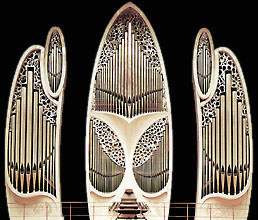 |
| "Hovering" Organs No, I don't mean those acoustic undulations called Celestes, nor am I talking of organs completely out of tune. You wouldn't believe it but there are organs that float above the ground so that they can be moved around in the church or concert hall. Basically this works like a Hovercraft, you have some rubber containers under the organ that can be inflated by the aid of compres-sors so that they will evenly and without any noise lift these tons and tons of an organ just a fraction of a millimeter so that it can be moved to any place in the church or on the stage via remote-control tractors. There are four hovering organs worldwide: |
||||
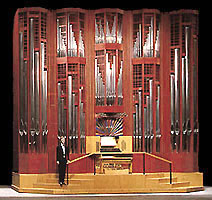 |
 |
• Australia, Adelaide, Festival Center 78 ranks / 50 voices / 3 manuals, weight: 11 tons built in 1978 by Rieger (see picture on the very left) • Switzerland, Neuchâtel, Collégiale 53 ranks / 38 voices / 4 manuals, weight: 14 tons built in 1996 by Saint-Martin (see picture on the mid left) • Syria, Damaskus, National Theatre 54 ranks / 40 voices / 4 manuals, weight: 18 tons built in 2000 by Laukhuff (see picture on the mid right) • Germany, Alpirsbach, Abbey Church 43 ranks / 34 voices / 3 manuals, weight: 16.5 tons built in 2008 by Winterhalter (see picture on the very right) |
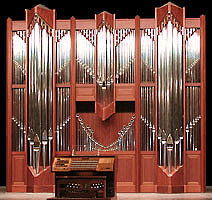
| 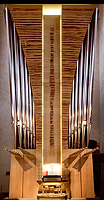 |
| Queer Organ Facades |
||||||
As early as in the middle of the 18th century people started to construct
quite daring organ cases and facades. The most sensational construction even until today is considered to be the
Weingarten Basilica organ (Germany). Joseph Gabler built it in 1713-1750 arranging the divisions around the church windows
with a detached console under a grape-shaped carillon. . .Here Gabler reached the limits of what was technically feasible and he set standards that are still valid today. It was only by introducing modern electric systems that organbuilders have become even more flexible in their way of arranging the facade. Still they usually do not go further than covering longer distances and linking several organs like in the Passau Cathedral (Germany). After leaving behind the Romantic phases with their mainly neo-Gothic facades organbuilders in the early 20th century decided to build free pipe facades where the pipes in the front were arranged according to geometric aspects only (often the facade would not contain a single speaking pipe). In the 1950ies to 1970ies many organs were even built without a case. Except for the ones in the Swell all pipes would be sitting on their wind chests in the open of the room – here are some examples: |
||||||
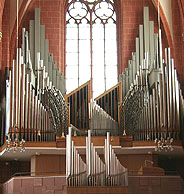 D, Frankfurt, Kaiserdom
D, Frankfurt, Kaiserdom(Klais, 1957) |
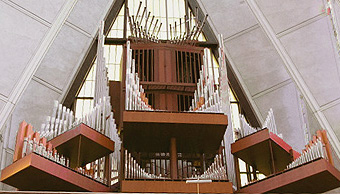 USA, Colorado Springs, Air Force Academy Cadet Chapel
USA, Colorado Springs, Air Force Academy Cadet Chapel(Möller & Holtkamp, 1962) |
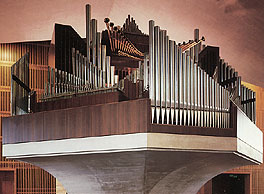 USA, San Francisco, St. Marys R.C. Cathedral
USA, San Francisco, St. Marys R.C. Cathedral(Ruffatti, 1971) |
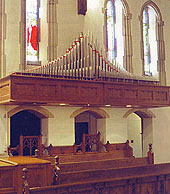 CAN, Toronto, St. Clement's A.
CAN, Toronto, St. Clement's A.(Casavant, 1928-2000) |
|||
Lately organ facades have been designed following such rigid geometric criteria or so fully incorporated in the overall design of the room that they are no longer perceived as separate entities. Or, on the other hand, they are arranged to give such a futuristic impression that you almost wouldn't think you were looking at an organ. Have a look at the following pictures – all of them are actually plain and simple organs. |
||||||
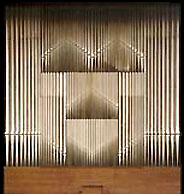 D, Munich, Herz-Jesu Church
D, Munich, Herz-Jesu Church(Woehl, 2004) |
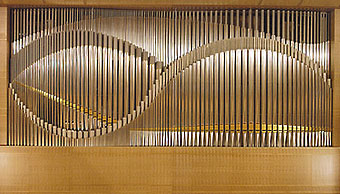 USA, Madison, Ouverture Hall
USA, Madison, Ouverture Hall(Klais, 2005) |
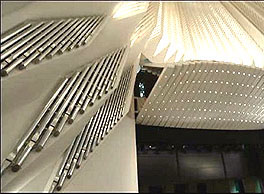 E, Santa Cruz, Auditorio de Tenerife
E, Santa Cruz, Auditorio de Tenerife(Blancafort, 2005) |
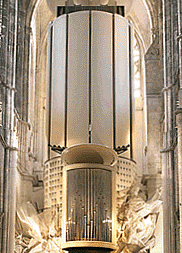 F, Evreux, Cathedral (Quoirin, 2006) |
|||
| Below to the left you have what is probably the messiest organ facade in the
World, arranged in a concert hall with an equally interesting interior design, next to it a "space organ", a merry-go-round type of thing dangling from the ceiling of the chapel, next an
organ following the idea of "the handy chocolate square" (with only the Spanish Trumpets poking out). Then there is the organ made from glass and steel only and finally to the right you
have a literally "handy" organ: |
|||||||||
 USA, Los Angeles, Disney Concert Hall
USA, Los Angeles, Disney Concert Hall(Glatter-Götz & Rosales, 2004) |
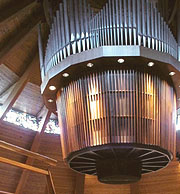 USA, Portland,
USA, Portland,Lewis and Clark College (Casavant, 1971) |
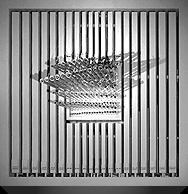 D, Cologne, Church of St. Peter
D, Cologne, Church of St. Peter(Willi Peter, 1971-2006) |
 D, Duisburg-Rheinhausen, Peace Church
D, Duisburg-Rheinhausen, Peace Church(Seifert, 1995) |
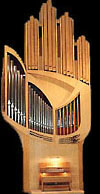 F, Alpe d'Huez, Notre-Dame
F, Alpe d'Huez, Notre-Dame(Kleuker, 1978) |
|||||
| As you saw in the picture of St. Peter's in Cologne Spanish trumpets are a very popular
element of design. Especially in North American organs they are a real "must". Often they are overblown and arranged separately on the main organ facade, or they are placed in a so-called
antiphonal organ on the other end of the church (actually, some antiphonal organs consist of only this one stop). In the Casavant organ of St. Clement's Anglican Church in Toronto (Kanada) (see picture on the right) there is a cross that blows you off your feet. I don't know what the designer had in mind designing a cross with not Jesus hanging on it – of course, he is risen – but instead a horizontal overblown Trumpet roaring at you. To my mind this is not really appropriate and I doubt its didactic value. Well, maybe they only use it on certain occasions, like when the Scripture reading is about Final Judgement or the last trumpet in the Apocalypse or maybe even the collapse of the wall of Jericho – that's about the only occasions that you could say they might fit. |
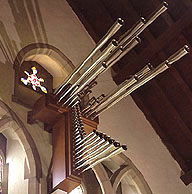 |
| The "Guinness Section of World Records" in Organ Stops Real 64' Stops: |
|||
|
The largest pipe of a 64' stop is more than 20 meters (22 yards) long and produces a frequency of about 8 Hz! Many large organs do have a 64' stop on the console and in their stoplists but
except for the organs mentioned below all of them are acoustic fakes, that is they are a combination of an existing 32' plus a Fifth extension 21 1/3' (that together produce a differential
tone giving a slight 64' impression. There are only three organs worldwide that have a complete 64' rank going down to the sub-subcontra-C: • AUS, Sydney, Town Hall: Contra-Trombone 64' (full length!) – sound sample here • USA, Atlantic City, Convention Hall: Diaphone-Dulzian 64' (full length!) • CZ, Olomouc, sv. Morice (St. Moritz): Untersatz 64'.
Then there are a few organs that have at least part of a 64': • USA, Salt Lake City, LDS Conference Center: Gamba 64' and Trombone 64' (4 pipes each, from Gis) • USA, Philadelphia, Kimmel Center for the Performing Arts: Contre Bombarde 64' (3 pipes, from A) • USA, Wichita Falls, First United Methodist Church: Ophicleide Héroique 64' (3 pipes, from A) • USA, Houston, St. John the Divine: Bombarde Ravalement 64' (3 pipes, from A) Real 42 2/3' Stops: The only complete sub-subcontra fifth in the whole world are to be found at USA, Atlantic City, Convention Hall: Diaphone-Dulzian 42 2/3' (Ext. of 64'). This makes the Convention Hall organ the only one able to produce an acoustic 128' (64' + 42 2/3' = 4 Hz difference tone on C). The organ at Cadet Chapel at West Point (USA) owns two 42 2/3' stops in their stoplist: Bourdon 42 2/3' and Dulzian 42 2/3' but they start at FFF (Quinte = CCC), so that they effectively are "only" 32' (extensions of existing 32' stops). |
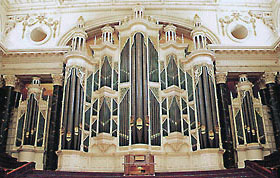 AUS, Sydney, Town Hall 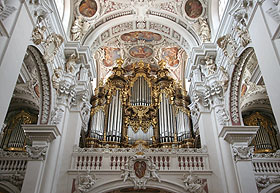 D, Passau, Dom St. Stephan |
||
|
The world's heaviest pipes: It's really hard to obtain information on the weight of single pipes, so obviously it is difficult to put up a ranking, but as far as I can tell the ranking according to weight is as follows: • USA, Atlantic City, Convention Hall: Diaphone-Dulzian 64' – 1,675 kg • AUS, Sydney, Town Hall: Contra-Trombone 64' – (the precise weight is unknown) • GB, Liverpool, Anglican Cathedral: Open Wood 32' – 1,117 kg (wall thickness 7.6 cm!) • USA, Atlantic City, Convention Hall: Diapason 32' – 1,100 kg Compare this to the subcontra-C of the Principal 32' in the Passau Cathedral organ: a "mere" 306 kg. Tallest, Oldest and Heaviest Pipe in the World: The world record in these parameters combined is held by the subcontra-C of the open Diapason 32' of the Lucerne Collegiate Church St. Leodegar ("Hofkirche") in Switzerland: The pipe was built by Johann Geissler around 1650 and is still in use in its original form. Its length is more than 10 meters, its diameter 57 cm (about 23") and its weight is 383 kg (844 lbs). Another special feature that – as far as I know – it only shares with the great organ at Sydney Town Hall is that it is sitting right above the console! |
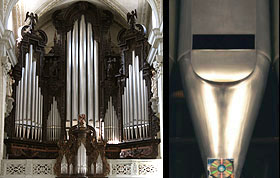 CH, Luzern, Hofkirche St. Leodegar |
||
|
Largest Number of 32' Stops: 32' stops are a basic to any large organ but due to their size and costs even large organs usually only have 2 or 3 of them. There do exist some organs with a lot more 32' stops (I'm only including complete 32' ranks actually going down to subcontra-C, no acoustic or digital ones): |
|||
|
• 9 x 32' in USA, Atlantic City, Convention Hall • 8 x 32' in USA, Los Angeles, First Congregational Church • 7 x 32' in USA, Philadelphia, Macy's ("Wanamaker") Store • 7 x 32' in USA, West Point, Cadet Chapel • 7 x 32' in USA, Salt Lake City, LDS Conference Center • 6 x 32' in USA, Washington, National Shrine of the Immaculate Conception • 6 x 32' in GB, Liverpool, Anglican Cathedral • 6 x 32' in AUS, Melbourne, Town Hall • 6 x 32' in USA, Pasadena, Lake Ave Congregational Church • 5 x 32' in USA, New York, St. Bartholomew's Episcopal Church • 5 x 32' in USA, Salt Lake City, Mormon Tabernacle • 5 x 32' in GB, London, Royal Albert Hall • 5 x 32' in AUS, Sydney, Town Hall • 5 x 32' in USA, Kenneth Square, Longwood Gardens • 5 x 32' in USA, Portland, City Hall Merrill Auditorium |
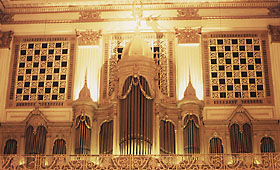 USA, Philadelphia, Macy's ("Wanamaker") Store |
||
|
Loudest Organ Stops: |
|||
According to the Guinness Book of World Records the Convention Hall organ in Atlantic City (USA) has the loudest
organ stop in the World, the Grand Ophicleide 16' in the Pedal. It is standing on 100" (about 2,500 mm) wind pressure, i.e. about 30 times what
you have in regular organ stops (even "high pressure stops" often only stand on 10-12" = 250-300 mm wind pressure)!
Some say the State Trumpet 8' in the Cathedral of St. John the Divine, New York (USA) which stands on 50" (about 1,250 mm) wind pressure is even louder. Others say the Tuba Magna 8' in the Anglican Cathedral, Liverpool (GB) which also stands on 50" wind pressure is the world's loudest organ stop... Undoubtedly, each one of these stops is at least as loud as any complete large organ. Highest Wind Pressure: |
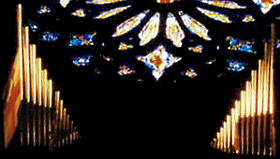 USA, New York, St. John the Divine |
||
|
The highest wind pressure ever used in normal organbuilding is 100" (about 2,500 mm). Little wonder that this record, combined with the record of the most powerful wind supply, goes to the
Atlantic City organ as well. Now here are the organ stops with the highest wind pressure worldwide: • 100" (2,500 mm) in USA, Atlantic City, Convention Hall: Grand Ophicleide 16' / 8', Tuba Imperial 8', Tuba Maxima 8' / 4' and Trumpet Mirabilis 16' / 8' / 4' • 50" (1,250 mm) in USA, Atlantic City, Convention Hall: Diaphone 32' / 16' / 8' / 4', Diaphone Phonon 16' / 10 2/3', Bombard 32' / 16' / 8' / 4', Major Posaune 16' / 8', Posaune 16' / 8' / 4', Tuba Magna 16' / 8' / 5 1/3' / 4', Harmonic Tuba 8' / 4', Ophicleide 8', Bugle 8' and Major Clarion 4' • 50" (1,250 mm) in GB, Liverpool, Anglican Cathedral: Tuba Magna 8' and Trompette Militaire 8' • 50" (1,250 mm) in USA, New York, Cathedral of St. John the Divine: State Trumpet 8' • 40" (1,000 mm) in I, Bologna, S. Giovanni Bosco: Gran Tuba 8' and 4' • 30" (750 mm) in GB, Liverpool, Anglican Cathedral: Bombarde 32' / 16' / 8' / 4' and Tuba 16' / 8' / 4' • 30" (750 mm) in USA, Jackson, First Baptist Church: Tuba mirabilis 8' • 30" (750 mm) in GB, Liverpool, St. George's Hall: Tuba mirabilis 8' • 30" (750 mm) in GB, London, St. Paul's Cathedral: Double Tuba 16', Tuba 8' and Trompette militaire 8' • 28" (700 mm) in D, Cologne, Cathedral: Tuba episcopalis 8' and Tuba capitularis 8' (installed on the West wall in April 2006) |
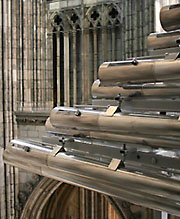 D, Cologne, Cathedral (Tubas) |
||
By the way, in Atlantic city there are whole divisions of the organ standing on wind pressures of 20-35". Almost the entire organ is on 15", which is still five times as much wind pressure as in an ordinary organ!
| |||
|
A very special outdoor organ named Vox Maris was constructed for the Expo 2012 in Korea by the German organ builder Hey (Ostheim/Rhön). This one eclipses every previous volume and pressure records: 138,4 dBa maximum level and up to 100,000 mmWS wind pressure. The organ comprises 80 pipes with a length up to 10 meters and is able to produce frequencies between 28 and 2,640 Hz. More informationen at Hey Orgelbau / Vox Maris. Largest Mixture: |
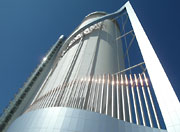 |
||
|
The mixture with the highest number of voices is the 49-ranks "La Force" of the
Weingarten Basilica organ (Germany), but it only can only be commanded by one key, the C in the Pedal.
So if you're honest you can't really call it a stop. Organs with several multi-rank mixtures (>12 ranks) are located in: • E, Santanyí (Mallorca), Sant Andreu: Plé 22-25 ranks • D, Amorbach, Abteikirche: Grobmixtur 12-16 ranks • F, Bordeaux, Sainte-Croix: Cymbale 13 ranks As there are many organs with mixtures of less than 12 ranks I have not listed them here. In the Gothic period, about in the 14/15 century, they used to have "Blockwerk organs" (principal choruses with up to 50 ranks) as basic voices, overtones (aliquotes) and mixtures were not yet playable separately. |
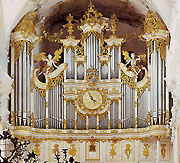 D, Amorbach, Abteikirche |
||
Cluster Cymbal: In the 16th and early 17th centuries in Poland - and only there and at that time - mixtures were built in a special type of construction: each note is a cluster of narrow-scaled Principal pipes soldered onto a common conical base. An organ with an original so-called Cluster Cymbal (11 ranks) is in the Holy Cross Church in Krakow (Polish: Kosciól sw. Krzyza). It was built in 1704 and restored in 2003. Cluster Cymbals are only preserved in very few, mostly unplayable organs, so the example mentioned in Krakow is a real rarity. |
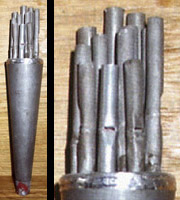 |
||
Strange aliquot stops (overtones): Usually you have octaves, fifths, thirds, sevenths and sometimes even ninths. Some organs also have fourths, sixths, major sevenths, minor thirds etc., as for instance... • USA, Atlantic City, Convention Hall: Eleventh, 32/11', 16/11', 8/11' • USA, San Francisco, Davies Symphony Hall: Aliquot 2-fach, 8/11' + 8/13' • D, Würzburg, Dom St. Kilian: [Major-]Septime 1 1/15' • D, Nuremberg, St. Sebald: Oberton 2 ranks, 8/11' + 8/13' • D, Altötting, St. Anna Basilika (main organ): Undezime 8/11' and Tredezime 8/13' • D, Cologne, St. Peter: Elfte 8/11' and Tredezime 8/13' • D, Landshut, Dominikanerkirche: Undezime 8/11' and Tredezime 8/13' • D, Nördlingen, St. Georg: Oberton 2 rangs, 1 1/7' + 16/19' • D, Düsseldorf-Oberkassel, Auferstehungskirche: Blues-Quarte 2 rangs, 1 1/7' + 16/19' and Guarneri-Terz 1 13/19' • D, Düsseldorf, Neanderkirche: Terzsept 2 rangs, 1 3/5' + 8/15' • D, Berlin, Epiphanienkirche: Aliquot 2 rangs, 16/22' + 16/27' • D, Kaufbeuren, Dreifaltigkeitskirche: Undezime 8/11' and Tredezime 8/13' • S, Stockholm, Högalid Kyrka: Tritonus 1 9/23' |
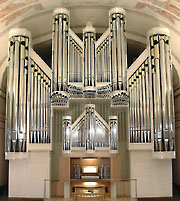 D, Düsseldorf-Oberkassel, Auferstehungskirche |
||
| If you are interested in the different organ stops and maybe a sound sample click here, if you would like to know more about pipe length and pitches click here. | |||
| The Largest Consoles: |
||||
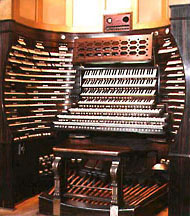 USA, Atlantic City, Convention Hall |
The World's largest console is in the
Atlantic City Convention Hall (USA), an organ that is holding several other records as well. It contains
7 manuals (the lower ones extend to 7 octaves as opposed to normally 5 octaves), 1,235 stop-keys and 7 swell pedals. This should be about the limit of what one single player would be able
to handle. |
|||
| Only 10 (playable) organs worldwide have consoles with more than 5 manuals: • 7 manuals: USA, Atlantic City, Convention Hall (449 ranks, 314 voices + 231 ext. + 127 tr.) • 7 manuals: USA, San Francisco, Castro Theatre (37 ranks, 37 voices + 49 ext. + 142 tr. + 398 digital) – under construction • 6 manuals: USA, Philadelphia, Macy's ("Wanamaker") Store (463 ranks, 374 voices + 18 ext. + 27 tr.) • 6 manuals: PL, Lichen, Basilica (222 ranks, 154 voices) • 6 manuals: KOR, Seoul, Sejong Culture Center (160 ranks, 96 voices) • 6 manuals: S, Malmö, St. Peter's Church (144 ranks, 106 voices + 63 ext. + 30 tr.) • 6 manuals: D, Waldsassen, Collegiate Basilica (141 ranks, 101 voices) • 6 manuals: I, Palermo, Duomo Monreale (137 ranks, 102 voices) • 6 manuals: USA, Hurricane, Forrest Burdette Memorial UMC (43 ranks, 27 voices + 346 digital) |
• 6 manuals: USA, Las Vegas, Phil Maloof Residence (43 ranks) – see explanation below
||||
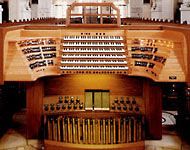 D, Waldsassen, Collegiate Basilica |
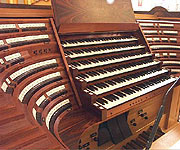 PL, Lichen, Basilica |
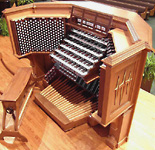 USA, Hurricane, F.B.M. UMC |
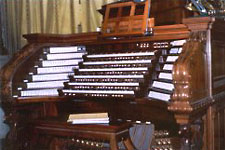 I, Palermo, Duomo Monreale |
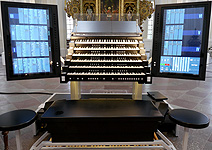 S, Malmö, St. Peter's Church |
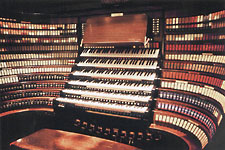 USA, Philadelphia, "Wanamaker" Store |
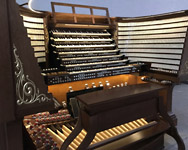 USA, San Francisco, Castro Theatre |
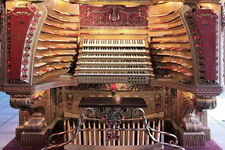 USA, Las Vegas, Phil Maloof Residence |
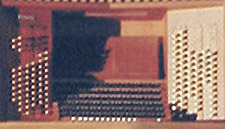 KOR, Seoul, Sejong Culture Center |
| In 1929 Walcker built a large organ for the World Exposition in the
Palacio Nacional Montjuïc (Barcelona, Spain) with 5 manuals, 168 ranks, 121 voices (+ 11 tr.) which was
rebuilt and enlarged to 6 manuals in 1955 by OESA (Organería Española, Madrid). Meanwhile this organ is completely unplayable, and whether a restoration will ever take place, is completely open.
You will find a photo of the OESA console here. In 1965 a 6-manual central console was built for the four organs of Mainz Cathedral (Germany) , which has been replaced by a 4-manual console during the complete rebuilt 2022. A photo of the former 6-manual console is included in this photo set at the bottom of the page. The large Barton theatre organ at Chicago Stadium (USA) also had a 6 manual console. The organ was dismantled and put into storage, and the console was was bought by Phil Maloof (Las Vegas, USA), who renovated it and connected it to his 43 ranks theater organ (Barton, 1931, with later additions). The stored organ of the Chicago stadium burned in a fire. Photos of the console can be found here and here. The world's largest drawknob console has "just" 5 manuals but 522 drawknobs and a total of 796 controls. It belongs to the organ at the Naval Academy Chapel, Annapolis (USA). Now, while you may doubt that a console with more than 5 manuals is really needed anywhere and would make sense ergonomically there is a museum in the US (who else would think of something like that!), the "House on the Rock" in Spring Green (Wisconsin, USA), where you can have a look at even larger consoles that even make those giants mentioned above look teeny-weeny: One monster has 8 manuals, one three-partite console has 3 x 5 manuals, i.e. a total of 15 manuals! |
||
Now there are two minor problems with these consoles:
|
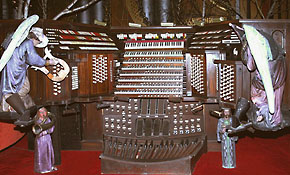 |
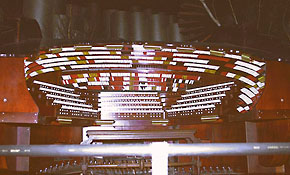 |
| National Records in Organ Size: The following table has the largest organs of 49 different countries, arranged alphabetically according to their country code. The size, just like in the organ database, has been determined by the number of ranks. For further explanations please turn to annnotations. Organs marked with è are also available onlinewith detailed stoplist and high-resolution pictures. All other organs are available by ordering the full online access subscription to the Organ Site. |
The largest organ ever built at one time is one of the last masterpieces constructed by M.P. Möller and was built for the Calvary Church in Charlotte (USA).
It has 205 ranks, 133 voices (+ 30 tr. + 39 ext. + 7 dig.) and 11,499 pipes on 5 manuals and the pedal.
| The smallest cathedral organs in Germany
The smallest cathedral ("Dom") organs in Germany, sorted by ranks (ascending): • D, Naumburg, Dom 42 ranks, 28 voices, 2 manuals – built in 1983 by Eule, renovated 2004 by Eule • D, Güstrow, Dom 44 ranks, 37 voices, 3 manuals – built in 1869 by Lütkemüller, restored 1986 by Jehmlich • D, Havelberg, Dom St. Marien 47 ranks, 32 voices, 2 manuals – built in 1693 by Scholtze, rebuilt by Heise and Lütkemüller, restored 2002 by A. Schuke (Potsdam) • D, Augsburg, Dom St. Maria 47 ranks, 36 voices, 2 manuals – built in 1904 by Maerz, restored 1984 by Kubak • D, Brandenburg, Dom St. Peter und Paul 51 ranks, 33 voices, 2 manuals – built in 1725 by Joachim Wagner, restored 1999 by A. Schuke (Potsdam) • D, Worms, Kaiserdom St. Peter 52 ranks, 34 voices, 3 manuals – built in 1985 by Klais • D, Fritzlar, Dom St. Peter 59 ranks, 45 voices, 3 manuals – built in 1929 by Klais, renewed 1995 by Klais • D, Meißen, Dom 61 ranks, 40 voices, 3 manuals – built in 1972 by Eule, renewed 2000 by Eule |
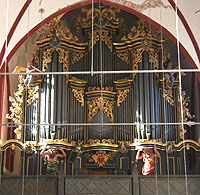 D, Brandenburg (Cathedral) |
| The world's largest tracker action organs
Here are all organs with at least 150 ranks with tracker (mechanical) key action: • AUS, Sydney, Opera House 200 ranks, 130 voices, 5 manuals, 10.154 pipes – built in 1979 by Ronald Sharp, renewed 2002 by Pipe Organ Reconstructions • D, Weingarten, Basilika 169 ranks, 63 voices, 4 manuals, 6.631 pipes – 1built in 1750 by Joseph Gabler, restored 1983 by Kuhn • D, Lübeck, St. Marien (main organ) 161 ranks, 100 voices, 5 manuals, 8.512 pipes – built in 1968 by Kemper • D, Ulm, Münster (main organ) 161 ranks, 98 voices, 5 manuals, 8.900 pipes – built in 1969 by Walcker, renewed 1997 by Tzschöckel • KOR, Seoul, Sejong Culture Center 160 ranks, 96 voices, 6 manuals, 8.098 pipes – built in 1978 by Karl Schuke (Berlin) • LV, Liepaja (Liebau), Trisvienibas Baznica (Dreifaltigkeitsdom) 152 ranks, 131 voices, 4 manuals – built in 1779 by Contius, enlarged 1885 by Grüneberg • J, Tokyo, Nihon Hosoo Kyoka (NHK) Concert Hall 151 ranks, 90 voices, 5 manuals – built in 1973 by Karl Schuke (Berlin) • H, Budapest, Mûvészetek Palotája (Milleniumdom, Philharmonie) 150 ranks, 104 voices, 5 manuals – built in 2005 by Mühleisen and Pécsi Orgonaépítõ • NL, Rotterdam, Sint Laurenskerk (main organ) 150 ranks, 84 voices, 4 manuals, 7.486 pipes – built in 1973 by Marcussen |
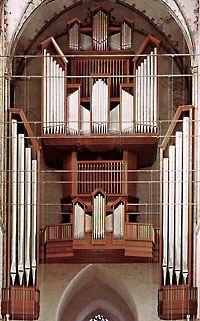 D, Lübeck, St. Marien (main organ) |
| The World's largest House Organ: |
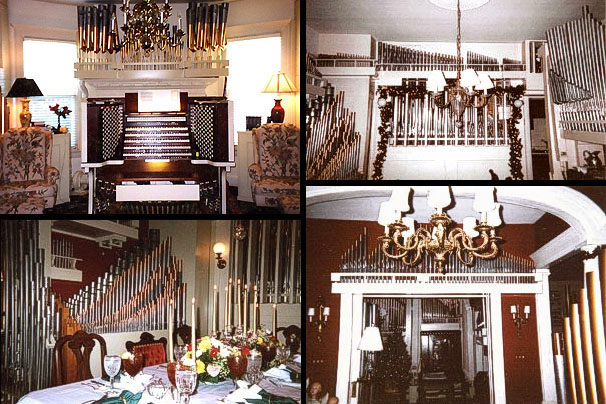 |
"Welcome to our humble abode": 200 ranks and 161 voices (registers) with a total of 11,200 pipes commanded by a five manual console.
Now, where on earth are we? In the US, obviously, at the Barry Norris Residence, Birmingham, Alabama, to be
precise. Wouldn't that be something – to have your own organ in your home, and one that is even bigger than most cathedral organs? Surely you wouldn't mind if there was not much room left in your home for anything beside the organ and if the acoustics would not quite come up to the acoustics in a cathedral... Even if its size might be just a tiny little bit exaggerated: the tutti on this organ must be impressive – definitely nothing for people with a heart condition. This organ is by far the biggest of its kind. The two organs next to it in size were built in the early 20th century and have by now been destroyed or sold in parts: • John Christie's organ (GB, Glyndebourne) by 1926 had 120 ranks / 107 voices (registers), including three true 32' rolled up in the basement! • J.M. Bowstead (GB, Wimbledon) continually enlarged his home organ so that by 1914 it contained about 119 ranks / 97 voices (registers), including three true 32'. Its five manual console controlled a total of 6,500 pipes. |
| Unusual Materials:
In general, organ pipes are made of a metal alloy or wood. But there are some organs where other materials have been given a try, such as bamboo, marble and even porcelain. Manufacturing porcelain pipes is particularly difficult since you not only have to construct a ceramic mould for each single pipe but also master the problem of possible shrinkage and changes in shape of the porcelain during the process of drying and firing. It had been tried around 1730 and later in 1920, but it did not work out. Now some years ago the Meissen porcelain factory in cooperation with Jehmlich Organbuilders (D, Dresden) finally succeeded in manufacturing and intonating a complete rank in porcelain. This "porcelain flute 2" sits in the facade (see picture below). |
||||||||
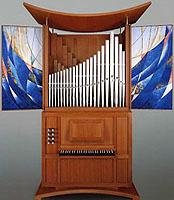 D, Dresden, Jehmlich Porcelain Organ |
In 2001 the Spanish organbuilder Ivan Larrea Belod (Novelda) built a positive that, apart from the bellows and parts of the action, was made completely of marble. All pipes of the only rank it has, "Tapadillo 4" (= Bourdon), as well as the case and the keys, are marble. This small organ positive weighs a total of 250 kg and is situated in a private residence in Los Angeles (USA). |
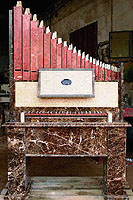 USA, Los Angeles, Private Residence |
Apart from the horizontal trumpets all pipes in this organ are made of bamboo. The builder was Fray Diego Cera de la Virgen del Carmen, an Augustinian monk who arrived from Spain in 1795 to serve as a parish priest in Las Piñas. He first kept the bamboo canes in salt water for several months in order to "impregnate" them, then he started building the organ. The organ was finally completed in 1821. In 1975 Klais organbuilders (D, Bonn) completely restored this organ. |
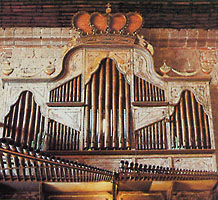 PHI, Las Piñas, RC Church |
||||
| As part of the International Building Exhibition 2017, an installation by Berlin artist Carsten Nicolai was erected in the
St. Ann's Chapel in Krobitz, Thuringia (southeast of Jena, Germany): A fire organ consisting of 25 glass cylinders arranged in double rows. After the flames have been lit individually by hand, the heat that flows through the glass tubes produces deep, vibrating tones. The fire organ is thus at once a musical instrument, an art object, and a source of light and heat. It was built by media artist Frank Fietzek (Werkstatt 4) and art producer Rob Feigel (yamaguchi-ufficio d'arte), both from Berlin. More information at the website of the Fire Organ Homepage. | 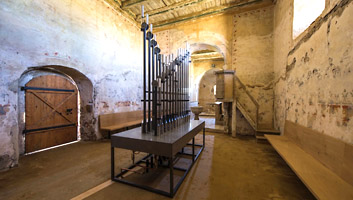 D, Krobitz, St. Annen-Kapelle – Feuerorgel |
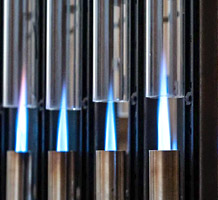 Feuerorgel - Detail |
||||||
| The World's slowest piece of organ music
In 1985 John Cage (USA, 1912-1992) wrote a piece for piano which in 1987 he transscribed for organ, "ASLSP" – "As slow as possible". In 1997, during an organ symposium in Trossingen (Germany), a group of organists, artists, organbuilders, theologians and philosophers had the idea to take this title literally and perform the piece over a period of more than 600 (!) years. The only instrument that could be considered for such a performance was the organ. So specifically for this project Romanus Seifert & Son organbuilders (D, Kevelaer) built an organ that will grow along with the project. The first chord was struck on February 5, 2003, the second in July, 2004, and so on. The next change of tone is scheduled for February 5, 2024. The final tone is said to be sounded in 2639. Site of the performance is the Burchardi church in Halberstadt (Germany), the origins of which go back to the 11th century. If you would like to know more about this organ project turn to the website of the John Cage Halberstadt Organ Project. Opening hours are included on the website. In the foreground of the picture to the right you can see the organ and what pipes have been used until now (more will be added as the need arises), the bellows are in the back, in front of the windows. |
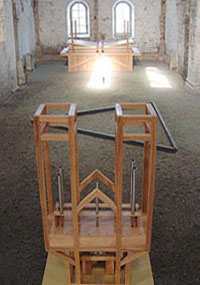 |


